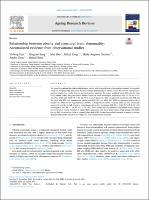Relationship between obesity and structural brain abnormality: Accumulated evidence from observational studies
Resum
Paraules clau
Índex de massa corporal; Anormalitats estructurals del cervell
Citació recomanada
Han YP, Tang X, Han M, Yang J, Cardoso MA, Zhou J, et al. Relationship between obesity and structural brain abnormality: Accumulated evidence from observational studies. Ageing Res Rev. 2021 Nov;71:101445.
Audiència
Professionals
Empreu aquest identificador per citar i/o enllaçar aquest document
https://hdl.handle.net/11351/7673Aquest element apareix a les col·leccions següents
- HVH - Articles científics [2972]
- VHIR - Articles científics [1202]
Els següents fitxers sobre la llicència estan associats a aquest element:


